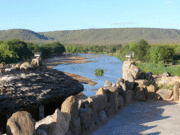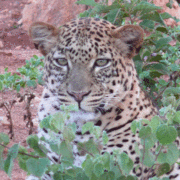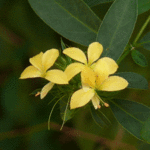11th November 2007
 Wednesday, November 21, 2007 at 10:11AM
Wednesday, November 21, 2007 at 10:11AM [PHOTOS FOR THIS ENTRY ARE COMING SOON...IN THE MEANTIME, WHY NOT CHECK OUT THE PHOTO STORIES I'VE ALREADY CREATED?]
Last night the sky behind the Yatta was ablaze with sheet lighting, and early this morning, at maybe 4 or 5am, we were awoken by the storm hitting us – real rain, falling heavily and steadily for several hours – joy!
The rain seemed to bring visible relief to the plants (or maybe that was just my imagination?) – certainly the flowerbed lilies and the acacia tree by the bird table seemed to look pert and sprightly. Both are growing apace, the lilies now vying for space in the small area where they sprouted, and the acacia showcasing new leaves each day. The Hippo Lawn was saturated, to the point where puddles actually formed on it. If we don’t see new grass sprouting there soon, we never will. The birds were up and about early for an insect feast (including the two Little Swifts who had spent the night in our room, fast asleep, hanging off the mosquito net, their heads tucked under their wings). The moss in our flowerbeds turned bright green. A new flower appeared in the balcony garden, self-seeded, like a tiny lilac jewel. The world seemed alive again.
A single old Buffalo waded across the river. He made a handsome picture. (But don’t be fooled, this is exactly the Buffalo you don’t want to meet when out walking: aged, solitary, and grumpy.)
And then the river started to come up, slowly but surely, bringing with it last night’s storm waters, until it filled its banks. As the water rose, new channels formed across the sand and the mudflats, and most of the islands and sandbanks disappeared. The weaver nest on the reed island was in danger of being swamped by the red water, coloured by the tonnes of soil it was carrying, evidence of chronic erosion upstream.
As the river started to claim more and more of the sandbanks, thousands of insects – newly hatched with the rain – fled in its wake, and this attracted the birds. We spent an hour at midday and a couple of hours in the late afternoon on the far sandbank (much reduced in size now) near the Hippos, where a varied congregation of wading birds and other water-lovers were feeding, rushing ahead of the flow of a small channel the rising river was cutting across the sand.
We watched a couple of giant crickets, washed out of their homes, rush across the sand and dig new burrows higher up. Within seconds, they had a new home.
It was so beautiful sitting down there, still and quiet so that the birds started to come right up close to us, without minding our presence. Identification of each species proved a challenge, especially with so many migrants newly arrived from colder climes. In the end, we decided the only way was to try photographing each bird, and then use the pictures as a reference when consulting the bird book back at the house. In addition to all the new, and as yet unidentified ones, some of the old favourites were there too: a Spur-winged Plover pair (trying to intimidate a small crocodile, and then conspicuously giving up that somewhat overwhelming challenge), a lone Egyptian Goose, three Hammerkops, and three Yellow Billed Storks. The Hippos were there too, in the red boiling river. Even for a hippo, it’s not easy navigating a large river in flood. One in particular caught our eye as it came up out of the water, for it had a deformed tooth, growing sideways and up outside its mouth – it could not have been comfortable. There were a couple of small crocodiles skulking at the water’s edge too, keeping out of the main current and taking advantage of the sun’s late rays.
The evening light was gorgeous – as it seems to be every evening here at Kulafumbi – and I could not resist taking some scenic shots too.
On the way back, we photographed a Red Chested Cuckoo that was calling, and the Go-Away Birds who like to frequent the canopies of the tall riverine trees, and always let you know they are there with their raucous cries.
There was some Hyena dung at the edge of the beach – conspicuous by its white colour, due to the hyena’s diet which consists largely of crunched up bones. What the three beetles were doing on the dung, I do not know, but they seemed to be vying for the best position, clambering one on top of the other.
After the dry months, it’s strange to see and hear the river so close beneath the balcony. The mudflats where the Impala and Dik-dik like to browse are underwater. The river is seething with crocodiles, which we have been watching by torchlight this evening. The eyes of those at a distance glow red in the beam, and those close by (at least ten huge ones) can clearly be seen below us in the water. They’ve been highly active since the river level rose, travelling up and down the river, in and out of the reeds, and fighting.
Tonight – you guessed it – the bugs are out in force. The heavy rain has caused the Flying Ants to hatch. But, under the mosquito net and out of their irritating reach, we feel smug. The sky is cloudless and alive with stars, so bright you can see them reflecting in the river. The night is brimming with sound: the floodwaters roaring, the frogs celebrating, the crickets buzzing, and an elephant ripping apart a tree not far from our bedroom window. The fireflies too are glowing and flitting out over the water, like magical mobile stars.
[PHOTOS FOR THIS ENTRY ARE COMING SOON...IN THE MEANTIME, WHY NOT CHECK OUT THE PHOTO STORIES I'VE ALREADY CREATED?]





Reader Comments